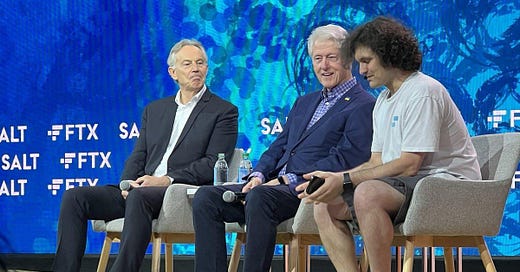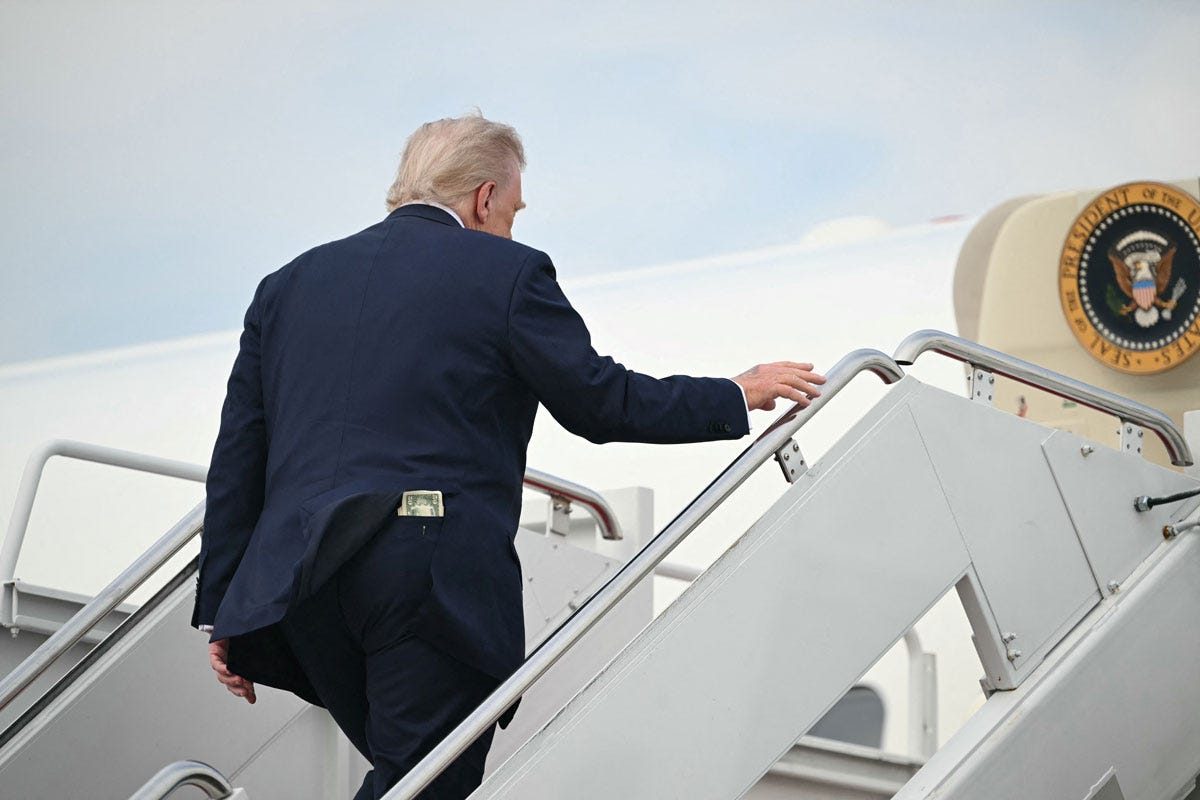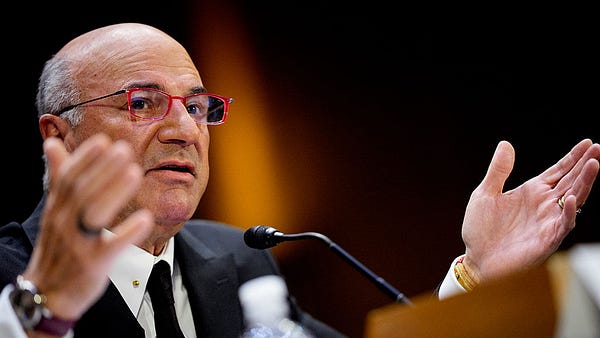
The Free Press

“The Next Warren Buffett.” That’s how Fortune magazine dubbed Sam Bankman-Fried, the crypto wunderkind who wore shorts, schlubby socks, and sneakers on stage with Bill Clinton and Tony Blair. But Bankman-Fried, worth an estimated $32 billion at his height, wouldn’t just be a financial oracle like Buffett. He would also be the second-coming of George Soros: By the end of this midterm election cycle, he’d become the second largest donor to the Democratic Party.
Over the past few days, all of that has come spectacularly undone.
Now, Bankman-Fried looks, at best, like the original storyline for Michael Saylor of Microstrategy during the Dotcom bust. Or, more likely, like Elizabeth Holmes of Theranos infamy. Or, with increasing plausibility, like a less civic-minded Bernie Madoff.
Tens of thousands of people who invested their savings on various FTX exchanges have likely been wiped out. FTX employees have quit en masse. And SBF? According to reports, he’s been taken into custody by Bahamian authorities after holing up at FTX HQ with his father.
Like everyone else in financial markets, I am glued to my screen.
If all you know about crypto are those Super Bowl ads with Matt Damon and Larry David hawking products and encouraging viewers to be “brave” and not miss out, the name Sam Bankman-Fried is probably new to you. Allow me to explain.
Born on the campus of Stanford University to two professors, he attended MIT, majored in physics, and from there joined Jane Street Capital, a noted employer of brilliant young programming talent on Wall Street. After three years, in 2017, Bankman-Fried was bitten by the crypto bug and founded Alameda Research, at the age of 25, to utilize the tools of traditional finance in the highly volatile crypto space.
As Alameda’s trading volume grew, Bankman-Fried apparently recognized the opportunity to monetize this volume by launching his own exchange, FTX. It first launched in unregulated Hong Kong to evade a tighter U.S. regulatory environment. Then, in 2020, FTX moved to the equally unregulated Bahamas as the political climate in Hong Kong deteriorated. (With both of his parents being Stanford Law professors, Sam was well positioned to understand the legal gray areas in which he was operating. But offshore banking is standard practice in the crypto world, so those geographic choices attracted no additional scrutiny.)
As FTX took off with the pandemic-driven crypto boom, so did a carefully cultivated Cult of SBF. Only two years after FTX’s founding, the company purchased naming rights to the NBA’s Miami Heat stadium in a 19-year commitment of $135 million. Deals soon followed for college stadiums. A Mercedes Formula 1 team. National Baseball League umpire patches. Partnerships with Tom Brady and Gisele Bundchen.
In short order, profiles of the boy genius appeared everywhere. As cryptocurrencies soared in market value, SBF became the poster child for the libertarian ethos that crypto profits accrued to those most capable. He seemed to have access to the glitterati previously reserved for those with established connections within the intellectual elite.
As a critic of crypto and its marketing mania, I found myself unsure in my assessment of SBF. Unlike many of the other dubious characters in the space, he appeared to be genuinely trying to build something of note, and his provenance at MIT and a top-tier Wall Street shop was certainly credible. As crypto-related businesses around the globe tumbled in this year’s selloff, he appeared to be taking a J.P. Morgan role—the banker at the center of the system, trying to acquire the broken pieces and assemble an empire that might successfully navigate the transition to a more regulated digital economy and marketplace. And he was doing it all in the name of future charity, as the popular face for a movement labeled “effective altruism.”
The venture capitalists at Sequoia—the powerful investors behind Silicon Valley success stories like Google and PayPal—were certainly taken (or taken in) by him. Three months ago, one of the firm’s partners, Michelle Bailhe, offered a breathless take in a firm-sponsored story about SBF:
“Of the exchanges that we had met and looked at, some of them had regulatory issues, some of them were already public,” Bailhe wrote. “And then there was Sam.” FTX, Sequoia felt, was “Goldilocks-perfect.”
In colorful language, Sequoia partners reveled in their appreciation for his pitch for FTX.com as the center of all monetary transactions. In their own words:
“I LOVE THIS FOUNDER,” typed one partner.
“I am a 10 out of 10,” pinged another.
“YES!!!” exclaimed a third.
The firm has since deleted the article.
Sequoia wasn’t alone. All told, SBF managed to raise over $1.4 billion dollars from various investors in two separate rounds of $1 billion and a prophetic “meme” round of $420.69 million dollars.
Over the last week, all those investments appear to have gone to zero. FTX, Alameda Research and 132 other related entities have declared Chapter 11 bankruptcy. Sequoia has written its investment down to zero. It makes the shenanigans at Twitter—which, incidentally, has been integral to the flood of information coming out on FTX—look like a cake walk.
The actual mechanics of what appears to have transpired are relatively straightforward and, at least initially, draw far more similarities to the DotCom cycle and MF Global than Bernie Madoff.
FTX appears to have raised capital beyond the venture capital previously highlighted by issuing its own “token” called FTT. Functionally, this is the same as selling unregistered, non-voting equity shares. It’s very similar to what Mark Zuckerberg did at Meta or Evan Siegel did at Snapchat: They issued super-voting shares that left them in control of the enterprise regardless of the views of shareholders. Self-minted crypto tokens, which is what FTX did, go one better. They fail to confer any governance or ownership rights to the holders. They exist only as prices on digital exchanges.
By simultaneously owning FTX, the exchange, and Alameda Research, the largest trader and market maker on the exchange, SBF was able to dictate the price of the FTT token and create the illusion that the value of the FTT token—and, by extension, FTX and Alameda—was substantial. He was able to use FTT like company shares, paying employees and vendors in FTT rather than U.S. dollars.
Unlike Elizabeth Holmes of Theranos, SBF gained his power by issuing securities to the unfortunate (and unaware) suppliers and customers of FTX. Instead of asking for money, he was giving it out. Amazingly, he all but admitted to this in a Bloomberg interview earlier this year:
You start with a company that builds a box and in practice this box, they probably dress it up to look like a life-changing, you know, world-altering protocol that's gonna replace all the big banks in 38 days or whatever. Maybe for now actually ignore what it does or pretend it does literally nothing. It's just a box…And then this protocol issues a token, we'll call it whatever, ‘X token.’ And X token promises that anything cool that happens because of this box is going to ultimately be usable by, you know, governance vote of holders of the X tokens…And of course, so far, we haven't exactly given a compelling reason for why there ever would be any proceeds from this box, but I don't know, you know, maybe there will be, so that's sort of where you start…And now what happens? Well, X token has some market cap, right? It's probably not zero. Let say it's, you know, a $20 million market.
This was a far more powerful approach, as it provided significant funds with which he could buy influence. And boy, did he try.
Naming rights to stadiums and celebrity endorsements were simply the start. There were partnerships with the professional e-gaming team TSM Esports for $210 million over a 10-year period. Bahamian crypto conferences with paid appearances by celebrity endorsers like Bill Clinton and Tony Blair. And on and on and on and on. SBF donations to Democratic primary candidates helped to shape the emerging regulatory regime for crypto and likely facilitated meetings with top regulators like SEC Chairman Gary Gensler. Making sure to keep his supporters’ attention, he suggested he was prepared to raise the stakes to between $100 million and $1 billion for the 2024 election.
Unfortunately, as is often the case, SBF’s ambition proved his undoing. If you’re going to issue non-equity equity and control its price through various manipulation schemes that would make Jordan Belfort of “The Wolf of Wall Street” proud—Belfort’s another crypto influencer, by the way—you must closely control the supply. During the crypto boom of Spring 2021, as FTX began its public relations blitz, Sam made a miscalculation. Likely at the urging of new investors like Sequoia Capital, he chose to buy out his China-based partner, Changpeng “CZ” Zhao, the founder of rival exchange Binance. If FTX, and by extension SBF, were going to become the face of crypto in the United States, it simply would not do to have a partner under investigation for money laundering by U.S. tax authorities. But rather than pay with then-unwanted U.S. dollars, SBF chose to buy out CZ with FTT tokens.
As the crypto boom turned to bust, the need to support FTT amid unbearable losses across the crypto universe led FTX’s affiliated trading arm, Alameda Research, to buy far more FTT than it sold. That left its balance sheet composed almost exclusively of FTT tokens. On November 2, this closely guarded information leaked to the press. Within days, disaster struck, as CZ apparently saw an opportunity to take out his protégé by dumping his half-billion-dollar hoard of FTT tokens.
The dumping of the FTT token drove the token's price down beyond the capability of Alameda to support it. Then, with market signals of distress rising, FTX faced its own crisis as rumors of distress led to an unsurprising run on the exchange, as clients withdrew funds. That’s when we discovered SBF’s real game: He had used the assets of clients of FTX to prop up Alameda's balance sheet at some unspecified point and had built a backdoor into FTX’s accounting systems to evade detection.
It is an absolute no-no to tap into client funds for company activities, as John Corzine, former governor of New Jersey, discovered when he used such funds to prop up his commodities broker, MF Global, during a trade that went bad. Like time in jail bad. Except John Corzine managed to parlay extensive political connections into a lenient conclusion. Pay it all back, and don’t do it again. We have to wonder if SBF saw the writing on the wall and hoped to achieve a similar outcome with his donations to the Democratic Party by becoming Too Big to Jail.
As disaster approached, CZ again returned on November 8 to consider a bailout. He passed. The inevitable scramble to call in aid from real-money investors, previously enamored of SBF, immediately followed and fell on deaf ears. At approximately 10:30 a.m. EST on November 11, Sam Bankman-Fried and his associated companies, Alameda Research, FTX and all his other related entities, filed for bankruptcy. As you might expect, he released the formal announcement on Twitter.
In the days since that tweet, the situation has only gotten worse. According to Reuters, at least $1 billion and potentially up to $10 billion of client funds have gone missing. In an apparent hack, perhaps by a disgruntled insider, FTX’s bank balances have been drained. Not content with a simple bankruptcy and wipeout, rumors are swirling that FTX insiders have fled for Argentina. Amidst the chaos, Sam apparently still finds time to monitor Twitter and manage his account.
So, what’s the conclusion? As I wrote here before and will repeat now: Just because the price of something is going up does not mean that it has an underlying value. That goes for Princess Diana Beanie Babies and Pogs, and it goes for Crypto and NFTs, too.
All cons must have an element of truth, or we would dismiss them immediately. And the saga of FTX and SBF offered us many reasons to be hopeful—a brilliant young billionaire with a heart of gold, a new source of economic growth, and the opportunity for financial independence.
Alas, it appears he is the latest to join a system rife with hucksters like Do Kwon, Faruk Fatih Özer, and Razzlekhan. When you find this many rats on a ship, it’s simply implausible that the center of the system is pure.
After years of neglect, perhaps the SBF and FTX debacle is enough to lead regulators to grapple with the knotty issues of crypto. The important decisions that are going to be made over the next several years will unquestionably bring us closer to the next evolution of money. Whether private, which I believe is highly unlikely, or state-sponsored, in the form of a Central Bank Digital Currency that carries its own considerable risks, it is almost certain that change in the monetary system is coming.
Predictably, the claims from the crypto community are increasingly coalescing around the argument that this was regulators’ fault. Enough nonsense, please. The industry, as it exists today, is built on a foundation of memes and lies. The objective has always been to drive panicked buying of a speculative asset, as the FTX saga demonstrates yet again. There are real issues with the global financial system, and the misinformation spread by the crypto industry has delayed rather than accelerated reform.
But that’s okay. Because Sam says he’s really sorry.
Michael W. Green is the chief strategist and portfolio manager for Simplify Asset Management. He’s been an active participant in financial markets for over 30 years.
Read the debate we published on Bitcoin between Michael and Balaji Srinivasan.
Or listen to Michael debate Anthony Pompliano on Honestly.
CORRECTION: An earlier version of this article said that FTX purchased naming rights to the NBA’s Miami Heat stadium for $135 billion. In fact, it was $135 million. We regret the error.















His parents have suggested that they will likely go broke defending their son.
Regulators should hold them to their word as they were active participants in the creation of the structure of FTX.
I have read somewhere that one of his parents specialized in the field of legal ethics. It true, it is a sad day for the law and a truly sad day for Stamford Law.
Nothing every changes... It's Tulip Mania all over again.